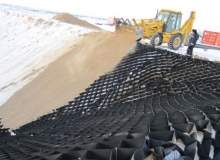

With some degree of fanfare, Geosynthetics Mining Solutions was introduced as the first ever conference dedicated to the use of geosynthetics in mining. The brainchild of mining information provider InfoMine, the conference was held in Vancouver in September 2014.
While not quite a buzzword, geosynthetics are clearly on the mining industry’s radar. Geomembranes, one of the largest groups of geosynthetics, were originally used for the lining of solid-waste landfills and, naturally lend themselves to heap leach mining due to their impervious quality.
It seems that it was only a matter of time before an event dedicated to the exploration of how to better foster such benefits came to fruition.
"A few years ago, Andy Robertson, who runs InfoMine, asked for suggestions for future conferences," explained Jack Caldwell, an engineer at Robertson GeoConsultants and a member of the technical committee that arranged the conference."I was at the time deep into the selection of geosynthetics for a mining project. I could find nothing applicable to the use of geosynthetics in the mining context. Thus it seemed a topic worthy of exploring."
It’s worth noting that the application of geosynthetics in mining differs drastically from the likes of landfill, road and municipal operations. First, one has to take into account the harsh environment of mines due to the heat and myriad chemicals and loads involved in mining structures. Also, mining waste disposal facilities need to be built with the long term firmly in mind, in contrast to most civil works.
Manifest interest: The success of the Geosynthetics Mining Solutions conference
Mine Location Intelligence, a mobile, location-based system created by ABB and Mobilaris, can both improve personnel safety and boost productivity.
As testament to the growing levels of interest in geosynthetics in mining circles, the event attracted big-name industry players such as SLR Consulting, the international environmental consultancy, which co-sponsored it.
In addition geosynthetics suppliers and installers displaying their commercial wares, keynote speeches were given by representatives from Ausenco and Tierra Group International as well as academic institutions including the Fulton School of Engineering and the University of British Columbia.
Looking back on the three-day event, Caldwell said: "I am confident in saying this was a first and valuable gathering of people who can make mining better and more cost-effective in the future, and whose products and work can make mining possible while protecting the environment. What more could one ask?"
It is somewhat surprising that it has taken up until now to hold a conference solely dedicated to the potential of geosynthetics in mining. According to Caldwell, this has much to with the fact that mining projects that harness geosynthetics still constitute uncharted waters.
"The mining projects that involve the use of geosynthetics are orders of magnitude larger than any other category of projects," he said. "The challenges are greater: there are few precedents, there are no substantive regulations and the consequences of use and misuse are greater."
Plugging the leak: What could geosynthetics bring to the environmental table?
But, as has been proven throughout its history, the mining industry is always open to a sea change. In recent years, this has been particularly obvious in the areas of of waste disposal and environmental control, which were again thrown into the spotlight by the Mount Polley mine disaster in British Columbia in August.
"The failure at Mount Polley was a topic of discussion at the conference," said Caldwell. "Opinions differed, but all concurred that the failures point to the need for a new way of managing mine waste. And many of the new ways involve smarter use of geosynthetics.
"Maybe from now on the only acceptable forms of mining will involve heap leaching — which involves extensive use of geosynthetics — or the placement of filter-pressed tailings in conjunction with geosynthetic liners, covers and leak detection systems.
"Maybe mining will have to go the way that solid waste landfill and ash disposal has been forced to go as a result of failures. Whatever, we believe that the innovative use of geosynthetics in mining is going to explode."
The next step: the need for greater dialogue
There is clearly much to suggest that geosynthetics and mining make for a strong fit, but that is not to say that there aren’t logistical and commercial hurdles that need to be overcome. As Caldwell explained, there is an abundance of geosynthetic products currently on the market – "most are good and many are amazing innovative", he says – but questions remain over whether engineers have the sufficient levels of knowledge to harness their power.
With insight from Mike Elliott, EY’s global mining and metals leader, Abi Millar profiles the current landscape of risk and reward in mining.
"The challenge for engineers is to understand the potential, choose the appropriate products and construct mining structures that are cost-effective because of the intelligent incorporation of geosynthetics," he said. "The march to success will be based on knowledge, calculations and judgment."
For the mining industry to make good on this, there needs to be greater cooperation between manufactures, suppliers and installers of geosynthetics. Consultants will also need to play a part, taking into account that mining personnel rarely have a say in the selection or purchase of geosynthetics.
"It is the consultants who control the choice of geosynthetics, and it is the contractors who control the purchase of geosynthetics in mining," said Caldwell. "That’s quite different from landfill and civil projects. Much adjustment is needed and those who make the adjustment will succeed.
"My challenge to the engineers, consultants, manufacturers, suppliers and installers of geosynthetics would be to make continued mining possible, responsible and profitable by coming up with good ways to use geosynthetics in mining. I am confident it can be done. I know it will not be easy; it will not be immediate, it will involve much argument and it may involve failures. But we must proceed. We must innovate. And we must succeed, for that is the way to make our current lifestyles sustainable."


.gif)

